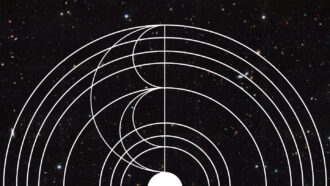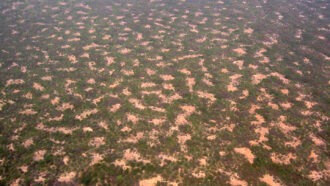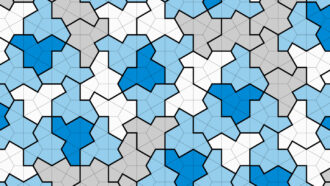Dense crowds of pedestrians shift into surprisingly orderly lines. Math explains why
New research into lane formation adds to decades of study on the wisdom of crowds
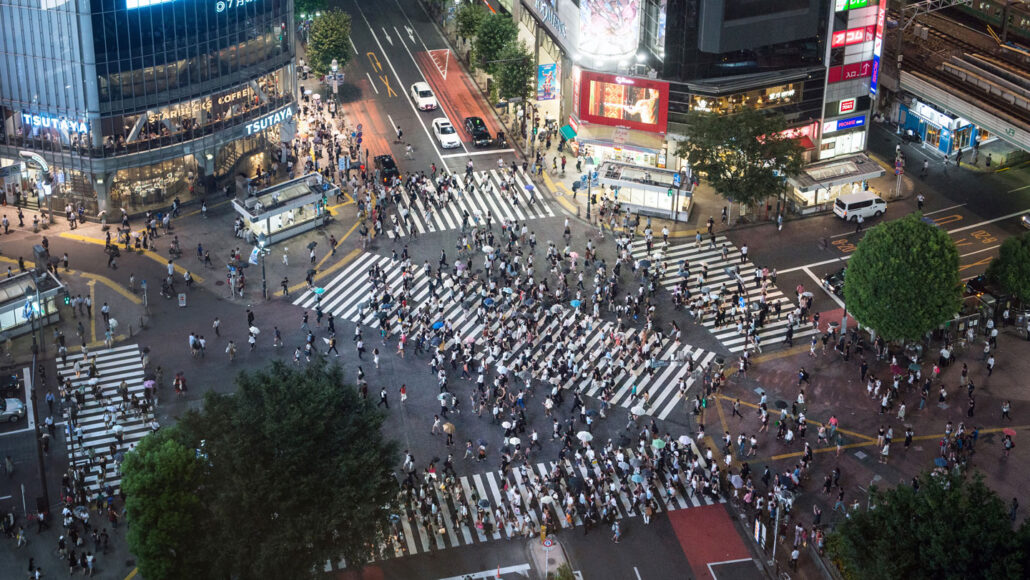
Pedestrians heading in opposite directions have long been known to form multiple parallel lines at big intersections such as Shibuya Crossing in Tokyo (shown).
Noppawat Tom Charoensinphon/Moment/Getty Images Plus
No matter how chaotic the train station at rush hour might seem, there’s likely more order than you think in that crowd.
It’s long been observed that in a dense crowd with people headed in opposite directions, multiple parallel lanes emerge. In a recent report in the March 3 Science, mathematicians Tim Rogers and Karol Bacik of the University of Bath in England used a mathematical model to describe how such lanes form and evolve and confirmed the predictions with live experiments.
The results show that, assuming the passageway is wide enough, two groups intersecting head on form multiple lanes roughly two body widths across. If the two groups instead intersect at right angles, they will again form lanes, which migrate like the stripes on a barber pole. (Each person stays in a lane but the lane itself moves to the side.) Even if you tell everyone to pass on the right in a misguided attempt to form just two lanes, you will instead get multiple lanes at an oblique angle to the preferred direction of flow. This slows everybody down.
Apparently, the best thing you can do to control the traffic is … nothing at all. “Anarchy is enough,” Rogers says.
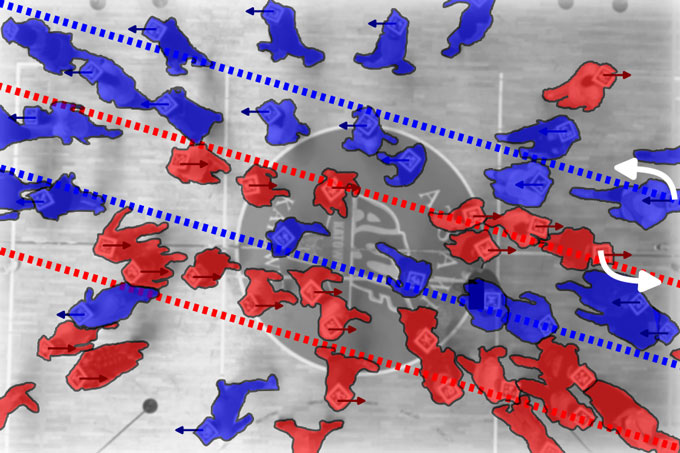
Rogers and Bacik began working on crowds during the pandemic — ironically, at a time when crowds were scarce. “We were working with a local civil engineering firm to design layouts for socially distanced use of spaces, including conference venues,” Rogers says. For example, how do you design a coffee break area so a large volume of people can pass through quickly while staying six feet apart? Although software already existed for simulating pedestrian traffic, it had to be tweaked for a new world in which the definition of a close encounter had changed.
While working on this practical problem, Rogers and Bacik became intrigued by the known phenomenon of spontaneous lane formation. As early as 1991, Dirk Helbing, a physicist now at ETH Zürich, had developed a mathematical model to explain the formation of lanes when two groups flow in opposite directions. Helbing’s “social force” model describes the intended direction of the pedestrians, as well as the way they modify their motion to avoid collisions. It remains a state-of-the-art model, and it was part of the software that Rogers and Bacik were using. The challenge for any such model is to bridge the gap between individual decisions and the patterns of the crowd.
“We rediscovered the various hypotheses that people have had, and we have tried to unify them and show that they are different parts of the big picture,” Bacik says.
In the new report, Rogers and Bacik describe lane formation as a result of two processes: drift and diffusion. As pedestrians are moving across King’s Cross Station in London, for example, they can drift from their planned route either because collisions push them away from regions with a lot of opposing traffic or because they are attracted to pockets that are more open. This drift strongly encourages lane formation: As soon as a stripe of northbound pedestrians starts to form, other northbound pedestrians are attracted to it and southbound pedestrians are pushed away. Diffusion, on the other hand, tends to smooth out fluctuations in pedestrian density, so an excess in one direction has to be fairly large to survive.
Subscribe to Science News
Get great science journalism, from the most trusted source, delivered to your doorstep.
Using a mathematical technique called perturbation analysis, Rogers and Bacik showed that fluctuations on the scale of two body widths dominate the formation of lanes and thus explain their width. “It’s a great idea, and I wish I had thought of it myself,” says Nicolas Bain of École Normale Supérieure in Lyon, France, who has also studied lane formation.
Beyond testing head-on traffic, intersecting traffic and passing on the right, Rogers and Bacik also tested two streams crossing in a square vestibule when one or both streams have to funnel through a narrow exit, such as a doorway. Here, a surprise emerged that no one studying lane formation over the past three decades had noticed before: The lanes that form are curved, making the shape of a parabola (if only one exit is narrow) or an ellipse (if both exits are).
Finally, the team tested all of these mathematical predictions in a crowd of 60 to 70 people passing through a 6-meter-by-6-meter arena set up in Katowice, Poland. (Bacik’s father, Bogdan, a biomechanics expert, helped arrange this experiment.) Their video footage confirmed the predictions. “It is the connection between the actual experiments and the simulations which makes the paper top-notch,” says Hartmut Löwen, a physicist at University of Düsseldorf in Germany who was not involved in the research.
While Rogers and Bacik’s recent work focused on pattern formation, pedestrian flow can have real and sometimes tragic consequences. Stampedes or crowd crushes have killed people — more than 150 people celebrating Halloween in Seoul in 2022, for example, and hundreds of pilgrims in Saudi Arabia in 2015. Public spaces can be designed to help prevent such tragedies.
According to Helbing, one sign of trouble is three-way (or more) collisions, where people have no good way to escape, and they get stuck. These collisions can occur particularly at Y-shaped intersections or at four-way intersections. Rogers and Bacik’s models specifically exclude such situations, and civil engineers would be well advised to avoid them too.
“Two pedestrian streams can walk through each other in a surprisingly efficient way,” Helbing says. But, Helbing adds, “When more pedestrian flows intersect, there are typically no stable patterns of motion.” This can lead to turbulent flow or “crowdquakes,” in which people can’t control where they are going. The takeaway: When pedestrians are traveling two ways, trust the wisdom of crowds. When there’s a three-way or four-way intersection, watch out.
